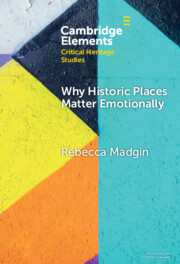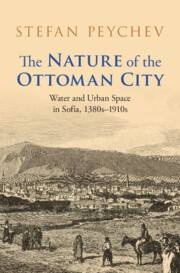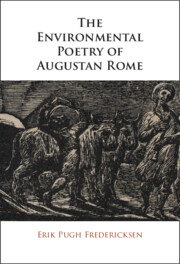Refine search
Actions for selected content:
129 results
21 - Re-Imagining Place (1940–1990)
-
-
- Book:
- The Cambridge History of Australian Poetry
- Published online:
- 19 November 2025
- Print publication:
- 11 December 2025, pp 400-419
-
- Chapter
- Export citation

Why Historic Places Matter Emotionally
- Responses - Attachments - Communities
-
- Published online:
- 22 October 2025
- Print publication:
- 13 November 2025
-
- Element
-
- You have access
- Open access
- HTML
- Export citation
Chapter 10 - Media arts and meaning-making with children in S.P.A.C.E: A living inquiry storied through place and technology
-
-
- Book:
- The Arts and Meaning-Making with Children
- Published online:
- 11 September 2025
- Print publication:
- 25 September 2025, pp 212-236
-
- Chapter
- Export citation
5 - Small Communities Nested in a Massive Community
-
- Book:
- Seniorland
- Published online:
- 04 September 2025
- Print publication:
- 18 September 2025, pp 67-92
-
- Chapter
- Export citation
Introduction
-
- Book:
- The Nature of the Ottoman City
- Published online:
- 28 August 2025
- Print publication:
- 11 September 2025, pp 1-26
-
- Chapter
-
- You have access
- HTML
- Export citation
Reworlding Together: Learning with Place through Cli-Fi Urban Role-Play
-
- Journal:
- Australian Journal of Environmental Education / Volume 41 / Issue 3 / July 2025
- Published online by Cambridge University Press:
- 08 September 2025, pp. 546-564
-
- Article
-
- You have access
- Open access
- HTML
- Export citation

The Nature of the Ottoman City
- Water and Urban Space in Sofia, 1380s–1910s
-
- Published online:
- 28 August 2025
- Print publication:
- 11 September 2025
God’s country: perceptions of religious and place-based candidate identities
-
- Journal:
- Politics and Religion / Volume 18 / Issue 3 / September 2025
- Published online by Cambridge University Press:
- 20 August 2025, pp. 432-453
-
- Article
-
- You have access
- Open access
- HTML
- Export citation
Chapter 1 - Representation
- from Part I - Origins Revisited
-
-
- Book:
- Space and Literary Studies
- Published online:
- 07 May 2025
- Print publication:
- 22 May 2025, pp 19-33
-
- Chapter
- Export citation
Chapter 20 - Sensory Geographies
- from Part III - Applications and Extensions
-
-
- Book:
- Space and Literary Studies
- Published online:
- 07 May 2025
- Print publication:
- 22 May 2025, pp 336-350
-
- Chapter
- Export citation

Space and Literary Studies
-
- Published online:
- 07 May 2025
- Print publication:
- 22 May 2025
Trends in the Female Longevity Advantage of Nineteenth-Century Birth Cohorts: Exploring the Role of Place and Fertility
-
- Journal:
- Social Science History / Volume 49 / Issue 2 / Summer 2025
- Published online by Cambridge University Press:
- 07 May 2025, pp. 422-443
- Print publication:
- Summer 2025
-
- Article
-
- You have access
- Open access
- HTML
- Export citation
1 - The Comfort of Screens
-
- Book:
- The Comfort of Screens
- Published online:
- 10 April 2025
- Print publication:
- 17 April 2025, pp 1-25
-
- Chapter
- Export citation
2 - Literacy in Postdigital Times
-
- Book:
- The Comfort of Screens
- Published online:
- 10 April 2025
- Print publication:
- 17 April 2025, pp 26-45
-
- Chapter
- Export citation
5 - Placing Screens
-
- Book:
- The Comfort of Screens
- Published online:
- 10 April 2025
- Print publication:
- 17 April 2025, pp 88-103
-
- Chapter
- Export citation
Chapter 6 - Translocal Lyric
-
- Book:
- The Environmental Poetry of Augustan Rome
- Published online:
- 12 December 2024
- Print publication:
- 19 December 2024, pp 228-257
-
- Chapter
- Export citation
Introduction
-
- Book:
- The Environmental Poetry of Augustan Rome
- Published online:
- 12 December 2024
- Print publication:
- 19 December 2024, pp 1-19
-
- Chapter
- Export citation
Chapter 1 - Local Dwelling and Pastoral Place in Vergil’s Eclogues
-
- Book:
- The Environmental Poetry of Augustan Rome
- Published online:
- 12 December 2024
- Print publication:
- 19 December 2024, pp 20-59
-
- Chapter
- Export citation

The Environmental Poetry of Augustan Rome
-
- Published online:
- 12 December 2024
- Print publication:
- 19 December 2024
Chapter 15 - Going to a Safe Place: (Re)Qualifying Market Sites in the Context of a Global Pandemic
- from Part IV - Markets in Motion: Places and Spaces
-
-
- Book:
- Market Studies
- Published online:
- 22 November 2024
- Print publication:
- 21 November 2024, pp 241-255
-
- Chapter
- Export citation
